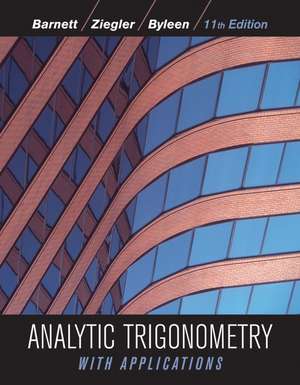Analytic Trigonometry with Applications
Autor Raymond A. Barnett, Michael R. Ziegler, Karl E. Byleenen Limba Engleză Hardback – 12 iun 2012
Preț: 872.69 lei
Preț vechi: 1660.34 lei
-47% Nou
Puncte Express: 1309
Preț estimativ în valută:
166.99€ • 172.28$ • 139.35£
166.99€ • 172.28$ • 139.35£
Carte tipărită la comandă
Livrare economică 27 martie-02 aprilie
Preluare comenzi: 021 569.72.76
Specificații
ISBN-13: 9780470648056
ISBN-10: 0470648058
Pagini: 624
Dimensiuni: 206 x 254 x 28 mm
Greutate: 1.14 kg
Ediția:11th Edition
Editura: Wiley
Locul publicării:Hoboken, United States
ISBN-10: 0470648058
Pagini: 624
Dimensiuni: 206 x 254 x 28 mm
Greutate: 1.14 kg
Ediția:11th Edition
Editura: Wiley
Locul publicării:Hoboken, United States
Public țintă
Trigonometry Lecturers and StudentsCuprins
1 RIGHT TRIANGLE RATIOS 11.1 Angles, Degrees, and Arcs 2
1.2 Similar Triangles 13
1.3 Trigonometric Ratios and Right Triangles 22
1.4 Right Triangle Applications 33
Chapter 1 Group Activity: A Logistics Problem 44
Chapter 1 Review 45
2 TRIGONOMETRIC FUNCTIONS 51
2.1 Degrees and Radians 52
2.2 Linear and Angular Velocity 65
2.3 Trigonometric Functions: Unit Circle Approach 72
2.4 Additional Applications 84
2.5 Exact Values and Properties of Trigonometric Functions 98
Chapter 2 Group Activity: Speed of Light in Water 112
Chapter 2 Review 114
3 GRAPHING TRIGONOMETRIC FUNCTIONS 121
3.1 Basic Graphs 123
3.2 Graphing and 138
3.3 Graphing and 157
3.4 Additional Applications 172
3.5 Graphing the Sum of Functions 187
3.6 Tangent, Cotangent, Secant, and Cosecant Functions Revisited 199
Chapter 3 Group Activity: Predator–Prey Analysis Involving Coyotes and Rabbits 211
Chapter 3 Review 212
Cumulative Review Exercise, Chapters 1–3 220
4 IDENTITIES 227
4.1 Fundamental Identities and Their Use 228
4.2 Verifying Trigonometric Identities 235
4.3 Sum, Difference, and Cofunction Identities 245
4.4 Double–Angle and Half–Angle Identities 256
4.5 Product–Sum and Sum–Product Identities 267
Chapter 4 Group Activity: From to 275
Chapter 4 Review 277
5 INVERSE TRIGONOMETRIC FUNCTIONS; TRIGONOMETRIC EQUATIONS AND INEQUALITIES 285
5.1 Inverse Sine, Cosine, and Tangent Functions 286
5.2 Inverse Cotangent, Secant, and Cosecant Functions 307
5.3 Trigonometric Equations: An Algebraic Approach 314
5.4 Trigonometric Equations and Inequalities: A Graphing Calculator Approach 327
Chapter 5 Group Activity: and 336
Chapter 5 Review 337
Cumulative Review Exercise, Chapters 1–5 343
6 ADDITIONAL TOPICS: TRIANGLES AND VECTORS 349
6.1 Law of Sines 350
6.2 Law of Cosines 365
6.3 Areas of Triangles 376
6.4 Vectors 383
6.5 The Dot Product 399
Chapter 6 Group Activity: The SSA Case and the Law of Cosines 409
Chapter 6 Review 410
7 POLAR COORDINATES; COMPLEX NUMBERS 421
7.1 Polar and Rectangular Coordinates 422
7.2 Sketching Polar Equations 431
7.3 The Complex Plane 444
7.4 De Moivre’s Theorem and the nth–Root Theorem 453
Chapter 7 Group Activity: Orbits of Planets 461
Chapter 7 Review 463
Cumulative Review Exercise, Chapters 1–7 467
Appendix A COMMENTS ON NUMBERS 473
A.1 Real Numbers 474
A.2 Complex Numbers 477
A.3 Significant Digits 481
Appendix B FUNCTIONS AND INVERSE FUNCTIONS 489
B.1 Functions 490
B.2 Graphs and Transformations 497
B.3 Inverse Functions 508
Appendix C PLANE GEOMETRY: SOME USEFUL FACTS 515
C.1 Lines and Angles 516
C.2 Triangles 517
C.3 Quadrilaterals 519
C.4 Circles 520
Selected Answers A–1
Index I–1
1.2 Similar Triangles 13
1.3 Trigonometric Ratios and Right Triangles 22
1.4 Right Triangle Applications 33
Chapter 1 Group Activity: A Logistics Problem 44
Chapter 1 Review 45
2 TRIGONOMETRIC FUNCTIONS 51
2.1 Degrees and Radians 52
2.2 Linear and Angular Velocity 65
2.3 Trigonometric Functions: Unit Circle Approach 72
2.4 Additional Applications 84
2.5 Exact Values and Properties of Trigonometric Functions 98
Chapter 2 Group Activity: Speed of Light in Water 112
Chapter 2 Review 114
3 GRAPHING TRIGONOMETRIC FUNCTIONS 121
3.1 Basic Graphs 123
3.2 Graphing and 138
3.3 Graphing and 157
3.4 Additional Applications 172
3.5 Graphing the Sum of Functions 187
3.6 Tangent, Cotangent, Secant, and Cosecant Functions Revisited 199
Chapter 3 Group Activity: Predator–Prey Analysis Involving Coyotes and Rabbits 211
Chapter 3 Review 212
Cumulative Review Exercise, Chapters 1–3 220
4 IDENTITIES 227
4.1 Fundamental Identities and Their Use 228
4.2 Verifying Trigonometric Identities 235
4.3 Sum, Difference, and Cofunction Identities 245
4.4 Double–Angle and Half–Angle Identities 256
4.5 Product–Sum and Sum–Product Identities 267
Chapter 4 Group Activity: From to 275
Chapter 4 Review 277
5 INVERSE TRIGONOMETRIC FUNCTIONS; TRIGONOMETRIC EQUATIONS AND INEQUALITIES 285
5.1 Inverse Sine, Cosine, and Tangent Functions 286
5.2 Inverse Cotangent, Secant, and Cosecant Functions 307
5.3 Trigonometric Equations: An Algebraic Approach 314
5.4 Trigonometric Equations and Inequalities: A Graphing Calculator Approach 327
Chapter 5 Group Activity: and 336
Chapter 5 Review 337
Cumulative Review Exercise, Chapters 1–5 343
6 ADDITIONAL TOPICS: TRIANGLES AND VECTORS 349
6.1 Law of Sines 350
6.2 Law of Cosines 365
6.3 Areas of Triangles 376
6.4 Vectors 383
6.5 The Dot Product 399
Chapter 6 Group Activity: The SSA Case and the Law of Cosines 409
Chapter 6 Review 410
7 POLAR COORDINATES; COMPLEX NUMBERS 421
7.1 Polar and Rectangular Coordinates 422
7.2 Sketching Polar Equations 431
7.3 The Complex Plane 444
7.4 De Moivre’s Theorem and the nth–Root Theorem 453
Chapter 7 Group Activity: Orbits of Planets 461
Chapter 7 Review 463
Cumulative Review Exercise, Chapters 1–7 467
Appendix A COMMENTS ON NUMBERS 473
A.1 Real Numbers 474
A.2 Complex Numbers 477
A.3 Significant Digits 481
Appendix B FUNCTIONS AND INVERSE FUNCTIONS 489
B.1 Functions 490
B.2 Graphs and Transformations 497
B.3 Inverse Functions 508
Appendix C PLANE GEOMETRY: SOME USEFUL FACTS 515
C.1 Lines and Angles 516
C.2 Triangles 517
C.3 Quadrilaterals 519
C.4 Circles 520
Selected Answers A–1
Index I–1
Notă biografică
Descriere
The 11th edition of Analytic Trigonometry continues to offer readers trigonometric concepts and applications. Almost every concept is illustrated by an example followed by a matching problem to encourage an active involvement in the learning process, and concept development proceeds from the concrete to the abstract.
